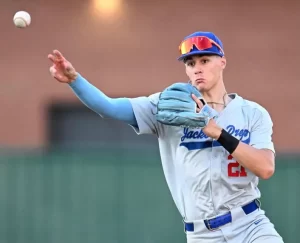White Sox draft Miami catcher Zack Collins with 10th pick
The moment has arrived. With the tenth overall selection in the 2016 MLB Amateur Draft, the White Sox have selected Zack Collins, a catcher out of the University of Miami.
The tweet length rub on Collins is that he’s a bat first backstop who flat out rakes. The longer version can be found in a profile I did on him about a week ago.
What you really need to understand about Zack Collins is that he’s a player that has eluded Chicago in recent years. Collins hits from the left side, has an excellent eye at the plate, and a clean stroke with flashy power. His 2016 regular season stat line tells a tale of its own: .381/.552/.645 (1.197 OPS) 8 2B, 11 HR, 51 RBI (51 games).
Don’t expect Collins to be a wizard behind the dish, in fact there’s a decent probability he moves away from the plate. However, as I said in my profile on him, Chicago would not have taken him 10th overall if they were wholly bearish on him being competent back there.
He has the arm to stick there but there are questions about his mobility. I think Chicago will give him every opportunity to prove himself, because if he’s average back there defensively then he might wind up being the steal of the first round. It’s just so rare in today’s climate to have a catcher with a decent hit tool, and even rarer for the White Sox.
Collins immediately becomes the White Sox’s top catching prospect on the farm, and this will make many ponder if this was a pick based on “need and fit” rather than the often lauded “best player available” strategy.
I think it’s a combination of both. Mercer outfielder Kyle Lewis unexpectedly fell to number ten and there’s definitely an argument that Lewis, with his tantalizing power, was the best player on the board. However, Lewis has considerable swing-and-miss in his game and it’s a profile Chicago has failed with time and time again. At least for me, he was always the lowest college bat on my board.
The player White Sox fans may regret passing on is Blake Rutherford, (who fell to the Yankees at #18), but I’m not ready to pass judgement quite yet because there was plenty of buzz around the industry that Rutherford was gunning for an overslot deal in a later round. We’ll never get a full picture of the discussions that took place between various players, agents, and clubs prior to the draft, but this is a reasonable scenario in regards to Rutherford.
If you wanted an a college arm like Justin Dunn or Dakota Hudson, take solace in the fact that Chicago felt confident enough to grab a bat. There was no secret this was a weak class for college pitching. Collins was likely the “best player available” when you include college hurlers.
So it’s not exactly all about fit, yet the fit is certainly uncanny. Collins will be profiled as the catcher of the future, but his bat is advanced enough that first base or designated hitter could be possibilities down the road. I’m not a fan of making a young talent that one dimensional so early in his career, but if the bat is rushed it wouldn’t be horrible.
Expect Collins to follow a similar track to Kyle Schwarber, although it’s irresponsible to expect similar immediate production. Sometime in 2018 is a good ETA for Collins, with him seeing the Windy City sooner if moved off the plate or more around 2019 if that’s where he sticks.
Anyway you spin it, the White Sox got a catch at number ten, especially if his defense improves and he becomes the rare two-way backstop.
WATCH: Zack Collins gets his name called, game analyzed and excitement captured all on @MLBNetwork #MLBDrafthttps://t.co/f4e5xHdIWF
— Miami Hurricanes (@MiamiHurricanes) June 10, 2016
Want to know right away when we publish a new article? Type your email address in the box and click the “create subscription” button. Our list is completely spam free, and you can opt out at any time.






